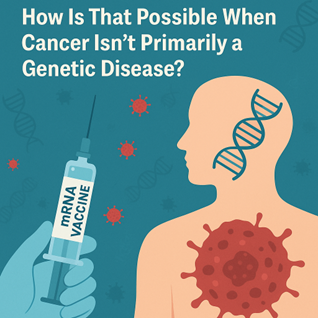
The sales pitch for mRNA cancer vaccines is to encode tumor mutations into an mRNA shot, “train” the immune system, and voilà, we have a personalized cancer cure. The reality: most cancers emerge from non-genetic conditions—chronic inflammation, hypoxia (low tissue oxygen), toxic metals, infections, and metabolic collapse—long before mutations become the headline. If you treat the genomic smoke while ignoring the biochemical fire, you get more hype than healing.
The entire mRNA cancer vaccine premise is based on a genetic mutation model that ignores the larger, evidence-backed role of inflammation, toxicity, and infection in cancer initiation. Yes, it sounds cool to fine-tune the immune system to target the specific genetics of one’s cancer with mRNA. However, mRNA is turning out to be a deadly poison, but the mainstream narrative is still that it’s safe and effective and certainly profitable.
Most medical and health experts do not understand cancer, and the proof of that is that cancer rates and cancer deaths are spiking up, not declining. I have always said that orthodox oncologists use treatments and diagnostic procedures that cause cancer to treat and diagnose cancer. A perfect example is mammography. Every mammogram a woman gets increases her risk of breast cancer by 5% due to the radiation involved, and mammograms frequently lead to overdiagnosis and unnecessary treatment. Imagine what PET and CAT scans do in this regard.
Modern Oncology is Not to Be Trusted
One in two women and one in three men will get cancer in their lifetime. Cancer is the second leading cause of death, claiming 600,000 American lives annually. By the 1970s, experts concluded that 80% of cancer is caused by environmental exposures, i.e., carcinogens we eat, smoke, breathe, swallow, or absorb. The incidence of 14 different cancers is steeply rising among those under 50. And young people are getting more aggressive cancers that are growing more quickly and have a worse prognosis. In young adults, symptoms are more likely to be dismissed, resulting in later, less treatable stages when diagnosed. Add the toxicity of mRNA vaccines, and all we will get is more cancer, more death, and suffering.
Most people sense that modern oncology is dangerous. Treatments are in no way intended to target the cause or causes of cancer, so even though the cancer industry is constantly talking about finding the “cure,” that’s the last thing on their agenda. Thinking that mRNA vaccines will address the causes of cancer is a fool’s dream at best and, at worst, an attempt to reverse Kennedy’s decision to cancel $500,000 in mRNA research. If the cause is environmental/physiological, not genetic, then targeting mutated sequences with an mRNA therapy is like changing the wallpaper in a burning house. Half a billion is a lot of money to spend on wallpaper. The government does not even have that money; it has to borrow every penny.
Kennedy, a longtime vaccine realist, is hated by the mainstream, and now he is being accused of increasing our chances of dying of cancer. Kennedy announced last week he will yank another $500 million from vaccines with mRNA technology. Kennedy has spread information that mRNA COVID vaccines are deadly and that vaccines “poisoned” American children. The mainstream news lies, saying “despite decades of public research and countless government assessments that have deemed them safe,” there is no getting away from the fact that this technology is a killer.
Recent research indicates that the cause of cancer has less to do with genetics and more to do with inflammation, nutritional deficiency, including oxygen deficiency, heavy metal poisoning, and infection. Common triggers of inflammation include chronic bacterial, viral, or parasitic infections, chemical irritants such as formaldehyde or toluene found in many cosmetics, or benzene found in oven cleaners, detergents, furniture polishes, and nail polish removers, inhaled particles from fiberglass, silica, or asbestos found in building materials and insulation. Ionizing radiation from frequent medical scans and X-rays, and even dehydration, will all cause inflammation and eventual cancer. That is the short list. In whose fantasy world would an mRNA cancer vaccine address any of these issues? You don’t cure a metabolic disease by mailing it more genes.
mRNA vaccines target genetic endpoints (neoantigens) but ignore hypoxia’s role in creating immunosuppressive, inflammatory environments that reduce vaccine efficacy. For instance, hypoxic tumors resist immunotherapy by downregulating antigens and recruiting anti-immune cells. The vaccines don’t resolve oxygen deficiency, infections, or toxins—upstream drivers you noted. In infection-related cancers, hypoxia worsens outcomes by enhancing viral persistence and inflammation. Real cancer prevention and treatment will only come when we restore the body’s environment, eliminate toxic exposures, treat hidden infections, and rebuild immune and mitochondrial health. No genetic patch can replace that foundation. So, though the medical establishment is crying about mRNA research being gutted, there are better ways to treat cancer, like massacring cancer with oxygen.
Hypoxia is a major environmental stressor that exacerbates inflammation, alters cell metabolism, and promotes cancer initiation, progression, and resistance to treatments. It ties directly into the non-genetic factors you mentioned, like nutritional/oxygen deficiencies, where damaged cells shift to acidic pH, mitochondrial dysfunction, and toxin buildup.
Hypoxia-driven tumor microenvironments suppress immune function and distort antigen presentation. That means even a well-designed neoantigen vaccine can underperform because the tissue environment has flipped into a state where T-cells are unable to recognize or respond. You don’t fix oxygen starvation, mitochondrial failure, or immune paralysis with a genetic payload.

Given enough time, cancer will develop whenever there is a proliferation of damaged cells. When cells are damaged, their cell wall permeability changes, toxins and free radicals build up, the mitochondria lose functionality in terms of energy ATP production, pH shifts firmly to the acidic, and essential nutrients are absent; cells eventually decline into a cancerous condition. We can see that when a person has cancer, they are rotting inside and dying from the loss of function, gathering infectious forces, and losing strength from malnutrition as the cancer cells eat us out of house and home. In whose fantasy world would an mRNA cancer vaccine address any of these issues?
In 2008, researchers in France found that one in six cancers is caused by treatable infections. Helicobacter pylori, hepatitis B and C viruses, and human papillomaviruses were responsible for 1.9 million cases, mainly gastric, liver, and cervical cancers. In women, cervical cancer accounted for about half of the infection-related burden of cancer; in men, liver and gastric cancers accounted for more than 80%. Around 30% of infection-attributable cases occur in people younger than 50 years.
The Yale Journal of Biology and Medicine tells us that, “Tumor promotion and progression are dependent on ancillary processes provided by cells of the tumor environment, but that are not necessarily cancerous themselves. Inflammation has long been associated with the development of cancer.”
“It is believed that cancer is caused by an accumulation of mutations in cells of the body,” says Dr. Carlo M. Croce, professor and chair of molecular virology, immunology and medical genetics. “Our study suggests that miR-155, which is associated with inflammation, increases the mutation rate and might be a key player in inflammation-induced cancers generally.” This and many other studies show how inflammation can help cause cancer. Chronic inflammation due to infection or to conditions such as chronic inflammatory bowel disease is associated with up to 25% of all cancers. In whose fantasy world would an mRNA cancer vaccine address inflammation?
Quick Reference: Causes vs. What mRNA Addresses
|
Driver (Upstream) |
What It Does |
Does mRNA Vaccination Address It? |
|
Hypoxia (low O₂) |
Triggers HIF-1α/NF-κB; immune suppression; resistance |
No |
|
Chronic inflammation |
DNA damage, tumor promotion |
No |
|
Infections (H. pylori, HBV/HCV, HPV, etc.) |
1/6 of cancers; persistent inflammation |
No (unless infection itself is targeted) |
|
Toxic metals/chemicals |
Mitochondrial injury, oxidative stress |
No |
|
Nutrient deficits / mitochondrial failure |
Low ATP, acidity, ROS buildup |
No |
|
Radiation exposure (diagnostics/therapy) |
Additional DNA damage/inflammation |
No |
|
Genetic mutations/neoantigens |
Downstream expression of disease |
Yes (downstream) |
Dr.Sircus is a reader-supported publication. To receive new posts and support my work, consider becoming a free or paid subscriber.
Subscribe now



comments